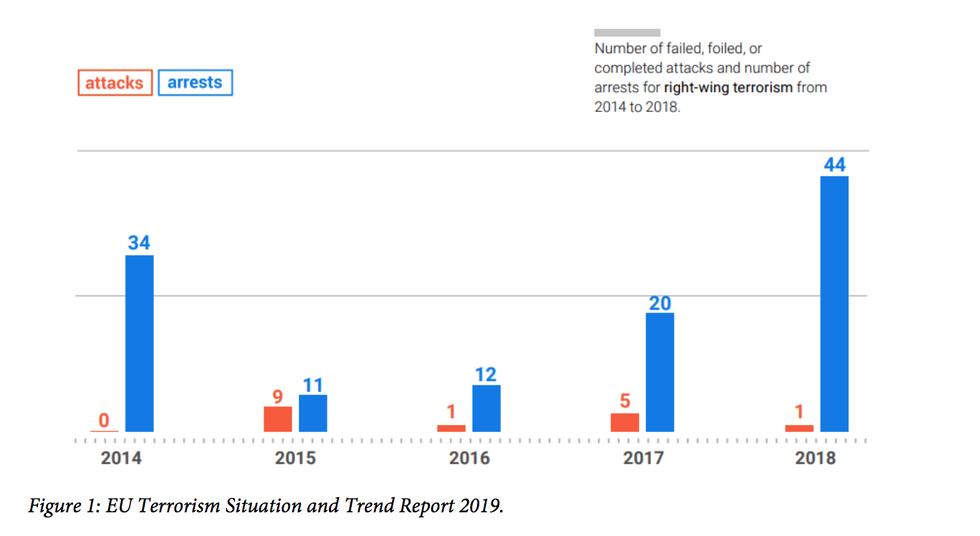CULTURE
Is Parler Dangerous? Everything You Need to Know About Online Extremism
14 Nov, 20

Parler Logo
Parler
As Twitter and Facebook attempt to crack down on misinformation and extremist rhetoric, many right-wing Americans are swearing off the social media platforms all together.
In their place, conservatives are turning to platforms like Parler that emphasize free speech and promise to never censor users’ content—no matter how violent it gets. Parler was the No. 1 free app downloaded through Apple’s App Store and Google Play on Tuesday, according to market research firm SensorTower, thanks to a mass conservative exodus from more mainstream platforms.
Parler users believe that Twitter has become far too “oppressive,” often citing Twitter’s decision to apply labels informing users that the information may be inaccurate to many of President Donald Trump’s posts during the week of the election. It is, of course, worth pointing out that none of Trump’s tweets were removed; they were simply marked as possibly inaccurate.
Parler released community guidelines on November 7th, specifying, “We prefer to leave decisions about what is seen and who is heard to each individual. In no case will Parler decide what will content [sic] be removed or filtered, or whose account will be removed, on the basis of the opinion expressed within the content at issue. Parler’s policies are, to use a well-known concept in First Amendment law, viewpoint-neutral.”
While many individuals on both sides of the political aisle have complained about the “echo chamber effect” that Facebook and Twitter’s algorithms create by primarily showing users content that they already agree with, it’s quickly becoming clear that Parler is a haven for radical right wing rhetoric, not free speech.
Angelo Carusone, president of Media Matters for America, a watchdog group that monitors news reports and social media, said, “A lot of the skeletons of the larger right-wing echo chamber have moved or set up shop on Parler, especially in the wake of some concerted actions by the platforms” like Twitter and Facebook to monitor misinformation and extremist rhetoric.
There have been a shocking number of violent threats made on the platform already. There even seems to be a rising call for civil war against “liberals” by users on Parler.
Some of the threats are even more specific, with one user, @bonsaiisuperstar, suggesting, “It’s time to hunt down and violently execute most Democrats, news media, college professors and millennials.”
Even Parler users not making violent threats are actively questioning the validity of the 2020 presidential election. On October 10th, the top hashtags on Parler included #ELECTIONFRAUD, #STOPTHESTEAL and #VOTERFRAUD. Of course, given that the sitting president is questioning the legality of the election (despite no evidence to suggest widespread voter fraud), it’s not surprising that even moderate Republicans are accusing democrats of election fraud.
But if the majority of Parler users are united in this common cause of invalidating the election results, how long until they unite behind other, more extreme causes, given the polarizing nature of social media sites? Isn’t that how these kinds of sites work?
As the Journal for Deradicalization says, “Although most theories of radicalization and ‘homegrown’ or ‘lone wolf’ terrorism rely on the Internet to explain why and how individuals moved from non-violent to violent political and religious activism, it is in most cases unclear how the mechanisms behind online based radicalization work.”
“But,” you must be thinking, “it’s obvious how the mechanisms behind online radicalization work. It’s simply confirmation bias. Surely Parler is going to radicalize lots of people!”
While this has long been what most experts assumed, the effect social media has on our political biases is not as simple as confirmation bias (the tendency to interpret new evidence as confirmation of one’s existing beliefs or theories). It actually has a lot to do with our tendency to want to be right when our preconceived notions are challenged and our tendency to only trust a few voices.
Let’s unpack those two factors.
Does diversity of opinions on social networks actually “neutralize” political bias?
We all know that it feels good to be right, and we’ve all argued in defense of a bad take just for the sake of refusing to admit we’re wrong. Essentially, it’s this same human tendency to fiercely stick to your preconceived notions, even in the face of strong contrary evidence, that drives political radicalization online.
According to a Duke University study, exposure to opinions different from one’s own may be the thing that pushes individuals further in the direction of their preexisting political ideology. Essentially, it’s not opinions you agree with that make you more radical; it’s opinions you disagree with.
The study, conducted by Christopher Bail and colleagues, gathered hundreds of individuals on both sides of the political aisle and paid them to follow a Twitter bot that shared political ideology and information that contradicted each individual’s own views.
As Greater Good Magazine explains, “After a month of exposure, the Democrats retained about the same attitudes—but the Republicans ended up more conservative than when they started the study! This result suggests that polarization in the U.S. could be driven by exposure to views people disagree with, rather than being separated from them by filter bubbles.”
While this seems antithetical to what you might intuit about how online echo chambers function, it actually makes a lot of sense when you think about Trump era rhetoric. So few fervent Trump followers actually claim to be for anything specifically. They can be most readily characterized by what they’re against: liberal ideology.
Trump is such a divisive character that, once he was elected in 2016, many people who were normally apolitical online began to rail against the new president. In response, Trump supporters seemed to get more and more extreme and vocal as time passed, making the left more vocal and extreme in response, and on the cycle went.
Now, in the face of what Trump supporters see as the biggest affront to their beliefs yet (Biden’s election), they’re leaving mainstream social media altogether and retreating to a place like Parler where they won’t have to be challenged at all.
So, surprisingly, it’s unlikely any previously neutral party is going to go to Parler and suddenly become radicalized. It’s a good bet that anyone turning to Parler has been, at least in part, radicalized by arguing with “liberal snowflakes” for the better part of the last four years.
Is the political echo chamber the polarizing force we think it is?
Now that these Trump supporters have left mainstream social media altogether, they’re unlikely to run into very many opinions that differ much from their own. But that doesn’t mean they’re going to be suddenly neutralized by the lack of oppositional opinions, as the Duke University study might suggest.
That’s because political echo chambers are more complicated than we think, and they actually have a lot to do with our tendency to only trust a few voices.
A study done by Scientific American suggests that our social networks online tend to be built around a few key “influencers.” These influencers don’t necessarily need to be famous or pushing sponsored products on you; they just happen to have the most connections within a certain network of people.
As SA puts it, “a small number of people, or perhaps just one person, at the ‘center’ of the network is connected to lots of other people in the ‘periphery.'”
What Scientific American found was that “the problem of partisan bias is exacerbated on social media because online networks are often organized around a few key influencers. This feature of social media is one of the main reasons why misinformation and fake news has become so pervasive.”
“In centralized networks,” they add, “biased influencers have a disproportionate impact on their community—enabling small rumors and suppositions to become amplified into widespread misconceptions and false beliefs.”
Basically, if someone has noticeable engagement from people you know on their social media posts, you’re more likely to trust their opinions. You’re also more likely to take their opinion or bias and pass it on in a way that amplifies and distorts the original intention—often making it more radical.
Donald Trump is a great example of one such influencer. The statements he shares on his Twitter page are not only often blatantly untrue, but set up a clear narrative of “Us vs. Them.” While he rarely directly incites violence against the Left, the spirit of his rhetoric does.
As more and more people share his posts and add their own interpretation of what he meant, the original message becomes obscured by the intent users assign to it. As this process goes on and more and more people share the post, the polarizing interpretation becomes the perceived meaning of the original post (which may have been full of implicit biases in the first place).
SA goes on to explain, “In a centralized echo chamber, if the influencer at the middle shows even a small amount of partisan bias, it can become amplified throughout the entire group.”
This is how political echo chambers really work: One centralized figure’s bias is amplified by their followers’ interpretations of their bias.
So how do you defeat centralized social networks?
So, knowing all this, what do we do about Parler? Well, Scientific American asserts, the way to defeat centralized networks that create political echo chambers is to make them into “egalitarian” networks. An egalitarian network is one in which every member of the network has equal contact with others in the network, giving them equal influence. Essentially, there is no centralized point.
Importantly, “In egalitarian networks, ideas spread based on their quality, and not the person touting them. There is a lot of wisdom in network peripheries, in regular people with good ideas. When the social network enables those people to talk with each other, new thinking that challenges a group’s biases can take hold and spread.”
Realistically, a truly egalitarian network is likely an impossibility in practice. But what if the biggest “social influencer” in the center of the centralized network of conservatives is not present? If Donald Trump never joins Parler, will it just peter out?
In fact, more generally, if Trump is no longer allowed to spew falsehoods and violent rhetoric from a place of power as the central point of many people’s social networks, will the rhetoric surrounding him begin to transform and become less and less extremist? Will conservative echo chambers like Parler begin to neutralize themselves since they lack a centralized head and users don’t have to face oppositional opinions?
This is likely an optimistic hypothesis, given the fact that right wing violence was a growing problem well before Trump’s election. Odds are, no matter how many times you cut off the head of the snake, a new head will simply appear to take the old one’s place.
But perhaps this era of deep division and extremist rhetoric will not end with a bang, but with a slow, drawn-out whimper. As Trump inevitably leaves office, perhaps his followers will begin to slowly separate themselves from each other via nuances of opinion, creating more egalitarian networks online.
Is Parler still potentially dangerous?
While we know that it’s not echo chambers that radicalize people so much as inflammatory oppositional opinions, and that Trump’s creation of a large centralized social network has a lot to do with the radicalization of the right—none of this means that Parler isn’t dangerous.
According to a report from the UN, “Extreme right-wing terrorists have consistently adapted to new spaces and new tools and have often been ‘early adopters’ of those tools.” Right now, that new tool is Parler.
The report continues, “Although extreme right-wing terrorism is not a new phenomenon, there has been a recent increase in its frequency and lethality.”
In fact, the report continues,”Research indicates that there has been a 320 percent rise in attacks conducted by individuals affiliated with such movements and ideologies over the past five years.”
 EU Terrorism Situation and Trend Report 2019
EU Terrorism Situation and Trend Report 2019
And while it’s difficult to determine a single cause of this increase, we do know that far-right wing terrorist groups and individuals are, more and more frequently, “seeking to mobilize others, often using the Internet.”
Based on this evidence, one can posit that online spaces like Parler bring already like-minded individuals together and weaponize pre-existing prejudices to push extremist thought into the realm of extremist action.
So while Parler may not radicalize previously neutral individuals, as you may have thought, it very well may be a dangerous tool in the hands of the already radicalized.
According to the United Nations National Security Council Counter-Terrorism committee, “The perpetrators of some recent terrorist attacks–including in Christchurch, El Paso, Halle and Bærum–announced their plans on 8chan or other, similar online forums and, in some cases, sought to live-stream their attacks on major platforms to maximize publicity and impact.”
So how do we counter far-right extremism?
A landmark Policy Brief called “COUNTERING THE APPEAL OF EXTREMISM ONLINE” written by Rachel Briggs and Sebastien Feve for the institute for Strategic Dialogue differentiates two types of government intervention to combat right-wing extremism: negative and positive measures.
Thus far in the battle against online extremism, governments have almost exclusively utilized negative measures. Negative measures are “reactive law enforcement measures designed to reduce the supply of ‘terrorist’ content, either through removal, filtering or hiding information.”
These negative measures require a lot of litigation against private sector enterprises to take-down content, blacklist keywords, and manipulate search results.
The brief asserts that since these strategies have proven to yield minimal success, it’s time that governments begin to utilize positive measures. Positive measures include:
1. Strengthen a populace’s digital literacy and critical consumption
Build capacity to enable users to critically engage with extremist content.
2. Digital Disruption: Increase counter-messaging activities
Enable the design and dissemination of online products that counter violent extremist narratives or direct challenge via forums and social media platforms and promote credible alternatives.
3. Build the capacity of credible messengers
Assist civil society to provide credible alternatives to violent extremism online.
As Briggs and Feve later assert, “There is a growing need for services, products and programmes that will enable young people to critically engage with extremist propaganda online. Similar initiatives have been undertaken in other areas of Internet safeguarding, such as in relation to bullying, paedophilia… and e-fraud, but there is very little tailored to the challenge of radicalisation.”
Essentially, we need to prepare Americans to confront and critically engage with extremist propaganda. School is meant to be intentionally apolitical, and while it’s important that no one tries to force beliefs on young minds, it’s equally important that our education system begins to prepare young people for the reality of an increasingly divided digital world.
While the dust continues to settle post-election, only time will tell how the increasingly agitated American far-right will handle the electoral defeat of their champion. But in the meantime, perhaps it’s best if the left simply ignore the rise of sites like Parler. Hopefully, its users get bored of shouting at each other soon enough.
While they continue to throw their tantrums, the rest of us can work on implementing positive education measures to prevent another generation of American minds falling for extremist rhetoric—right-wing or otherwise.













